IDEX Online Research: US Retail Jewelry Prices Drop For Third Straight Month
December 22, 13
(IDEX Online News) – American consumers saw a further decline in retail jewelry prices last month following modest declines in October and September, while inflation at the supplier level was largely unchanged and moved sideways.
JCPI Declines Slightly in October
For November 2013, the Jewelry Consumer Price Index (JCPI) stood at 166.2 compared with 169.9 in October. Here’s what this means:
- Retail prices of jewelry dropped by 2.2 percent on a month-to-month basis: November 2013 versus October 2013.
- Retail jewelry prices increased by 0.7 percent on a year-to-year basis: November 2013 versus November 2012.
The graph below shows the movements in the JCPI over the past two years, with the outstanding feature being the wide-scale fluctuations in retail jewelry prices over the period.
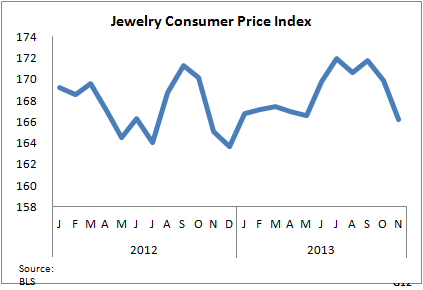
Retail jewelry prices have moved up and down in a relatively wide range this year, a result of consumer demand for jewelry rising and falling. But retailers can take comfort from the fact that retail spending has remained solid despite the raising of prices by retail jewelers from late summer onwards.
That is usually the result of retailers aiming to acclimatize shoppers to higher prices. The decline in October was a sign of a slowdown in overall retail demand and the further drop last month may indicate their inability to persuade consumers to pay higher prices as competition strengthened with the critical holiday selling season underway.
The graph below gives an historical perspective relating to movements in the JCPI over the past three and a half years.
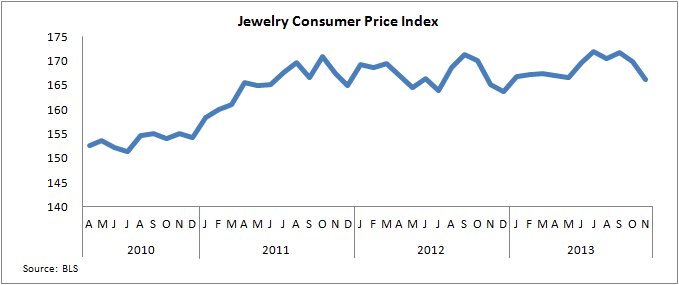
JPPI Stands Still in November
For November 2013, the Jewelry Producer Price Index (JPPI) came in at 211.9 compared with 211.8 for the month before – in other words, it stayed just about unchanged. Here’s what this means:
Wholesale jewelry prices stood still on a month-to-month comparison basis: November 2013 versus October 2013.
Wholesale jewelry prices fell by a sharp 3.5 percent on a year-to-year comparison basis: November 2013 versus November 2012.
The graph below summarizes monthly JPPI over the past two years.
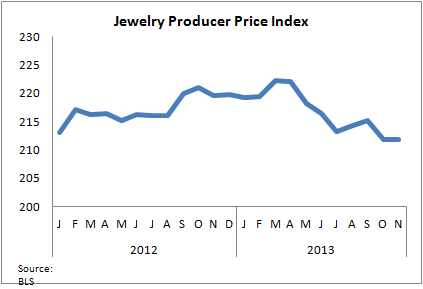
Jewelry suppliers’ prices declined from last year’s levels due to lower prices of precious metals including gold, silver, and platinum, while a slight rise in prices of polished diamonds served to cancel out some of the decline in precious metal prices.
Clearly, jewelry suppliers price their goods based on changes in the cost of raw materials. Over the past year, those costs have fallen, with gold prices down by more than 20 percent and silver prices dropping by in excess of 30 percent. Consequently, it comes as little surprise that wholesale jewelry costs are lower this year than last year.
Because the overall global economy is still in a slow-growth mode, jewelry price inflation is expected to remain moderate for the foreseeable future.
The graph below shows the interaction between supplier and retailer inflation over the past two years. The blue line represents retail prices of jewelry in the U.S. market while the red line represents wholesale prices.
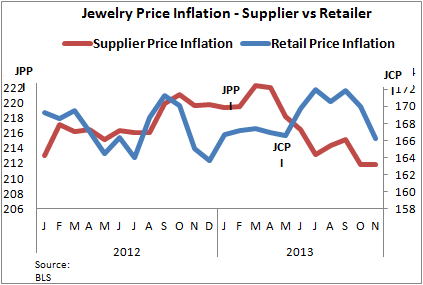
The graph below shows the decline in suppliers’ jewelry prices on a year-to-year basis. Suppliers’ prices have dropped more sharply in recent months, as can be seen on the graph.
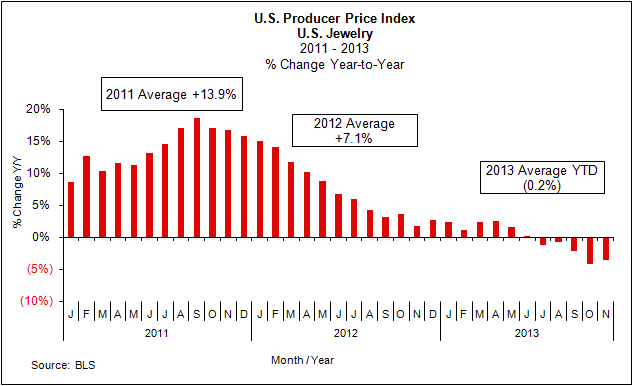
The graph below illustrates the change in monthly retail jewelry prices on a year-to-year basis: November 2013 versus November 2012. It is clear that inflation has been very modest this year at the retail level.
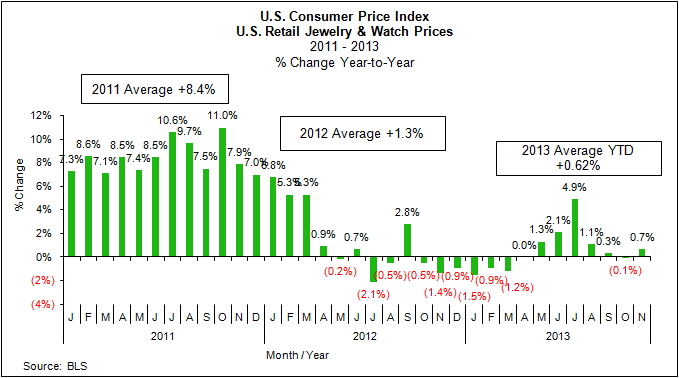
The Bottom Line:
Key Factors Affecting Deflationary Price Trends in US Jewelry Industry
As precious metals and polished diamond prices have declined this year, both suppliers and retailers are reducing the prices of their goods to reflect deflation in underlying jewelry commodities, as the tables below illustrate.
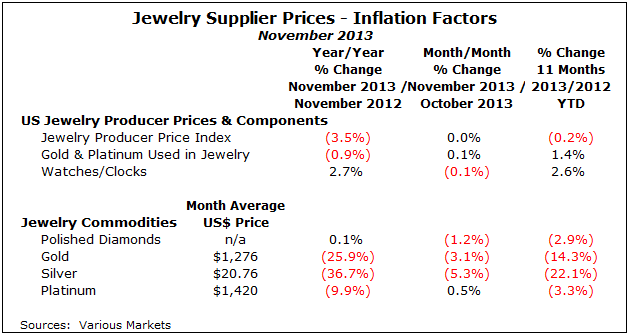
Inflation Likely To Remain Moderate
What do the coming months hold for jewelry price inflation? It seems clear, at least for now, that prices are constrained by the painfully slow economic expansion in the United States. Sales have remained solid for most of this year, with consumers buoyed somewhat by rising stock markets and house prices.
And the US economy received further good news a week before Christmas with a surprisingly strong jump in growth, the fastest pace in almost two years in the third quarter, as it rose at an annualized rate of 4.1 percent. The growth rate was higher than forecasts of 3.6 percent, and marks a rapid acceleration from the second quarter when the annualized GDP stood at 2.5 percent. The rate of economic expansion is also the highest the country has seen since the fourth quarter of 2011, and the second highest since the recovery began in mid-2009.
The fly in the ointment is that some economists pointed out that more than one-third of growth was due to businesses placing orders for extra goods rather than a jump in demand from consumers. Consequently, that would suggest that underlying demand in the US is still depressed. Some analysts are even predicting a drop in GDP in the first quarter of 2014 as those businesses sell off their backlogs of stock, while others are predicting that the strong rise in GDP would be the start of sustained growth.
Consequently, prices of precious metals – gold, silver, platinum – would appear to be likely to remain at current levels in the coming months.